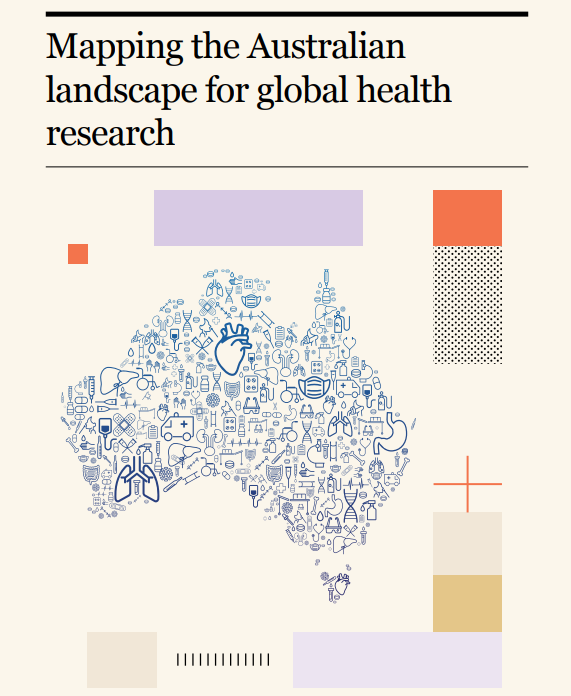Mapping the Australian landscape for global health research
By Impact Global Health 28 July 2025
Overview
The Australian Global Health Alliance commissioned this analysis by Impact Global Health as part of a series of reports mapping the global health landscape. We are grateful to the Australian Global Health Alliance secretariat, members of the steering committee and all contributors to this report for their work.
Key messages
- Funding for global health research makes up a tiny fraction of Australia’s overall health budget.
- Infectious diseases have been a key focus of funded research, even prior to the COVID-19 pandemic.
- Ongoing health disparities underscore the need for further investment in Indigenous health.
- Funding commitments are insufficiently forward-looking, not focusing on emerging threats such as the implications of climate change on health and food security, and antimicrobial resistance.
- Australia has both the economic capacity and research expertise to become a leader within our region.
- From 2017 to 2023, the Australian federal government’s health spending totalled approximately $630 billion. Although still a significant investment, global health research represented only a tiny fraction of the overall health budget, receiving just under $2 billion over the 6-year period.
- The distribution of public sector funding for global health research in Australia is primarily managed by four key agencies: the NHMRC, MRFF, ARC, and DFAT. These agencies collectively influence the national agenda on global health research.
- A significant focus of funded research has been on infectious diseases – with substantial allocations directed largely towards the study, treatment, and prevention of COVID-19, as well as influenza, tuberculosis, and mosquito-borne diseases – as well as Indigenous health, with research largely directed towards health issues which disproportionately impact Indigenous populations, including rheumatic fever and maternal & child health.
- Australia stands out in Indigenous health research funding among high-income nations, with the NHMRC leading compared to equivalent organisations in Canada and New Zealand, both in total expenditure and relative to the size of each country’s Indigenous population. However, ongoing health disparities underscore the urgent need for more focused and culturally adapted strategies.
- Funding commitments are insufficiently forward-looking and still, in many respects, represent the funding priorities of recent years, not considering emerging threats such as the implications of climate change on health and food security and antimicrobial resistance.
- There needs to be an increased focus on – and greater strategic coordination of – investment in global health research by the Australian government, the majority (around two-thirds) of which is currently researcher-driven.
- The MRFF has significant potential as a source of strategic investment in global health research, but only a small – and decreasing – fraction of its funding is directed to global health.
- To better align with global health needs and maximise impact, Australia must increase and realign its funding strategies to address and anticipate global health challenges more effectively, especially in underfunded areas such as climate-related health issues, antimicrobial resistance, and pandemic preparedness.
Executive summary
This report, Mapping the Australian Landscape for Global Health Research, provides an in-depth analysis of Australia’s public sector funding for global health research from 2017 to 2023. As a high-income country, Australia has the potential to play a significant role in addressing global health challenges, especially within the Indo-Pacific region. The report highlights both the strengths and gaps in Australia’s global health research funding.
The report focuses on four major public agencies – the National Health and Medical Research Council (NHMRC), the Medical Research Future Fund (MRFF), the Australian Research Council (ARC), and the Department of Foreign Affairs and Trade (DFAT) – as the primary funders of global health research. While each of these agencies have made notable contributions, especially in areas like infectious diseases, sexual and reproductive health, and Indigenous health, the overall scale of funding remains modest relative to Australia’s economic capacity.
Key areas of focus in Australia’s global health research include infectious diseases, with nearly half of the total global health funding going to diseases like COVID-19, tuberculosis, and malaria. Sexual and reproductive health, particularly in the prevention and treatment of HIV/AIDS and cervical cancer, also received significant investment. Looking at Australian funding for Indigenous health compared to that of Canada and New Zealand, Australia has invested the most in terms of absolute funding and funding relative to Indigenous population size; however, once the GDP of each country is factored in, New Zealand performs the best.
Despite commendable efforts, Australia’s investment in global health research lags behind its international peers. This finding underscores a misalignment between current funding strategies and the emerging global health threats. Key areas such as the impact of climate change on health, antimicrobial resistance, and pandemic preparedness are notably underfunded. This oversight suggests that current investment strategies remain anchored in historical priorities and have not evolved sufficiently to address the shifting landscape of global health challenges increasingly influenced by environmental and geopolitical changes. The report advocates for increased funding in these under-researched areas and the realignment of Australia’s health funding to reflect better global health priorities in areas where Australia can make a substantial impact.
While Australia has made strides in addressing global health challenges, significant gaps remain. The report highlights the need for increased funding, particularly in areas of emerging importance. By strategically enhancing its global health research investments, Australia can address pressing health challenges at home and abroad, strengthen its role as a global leader, improve regional stability, and build the capacity of Australian researchers and the Australian research sector.
